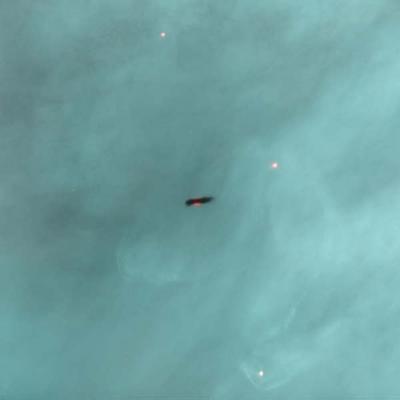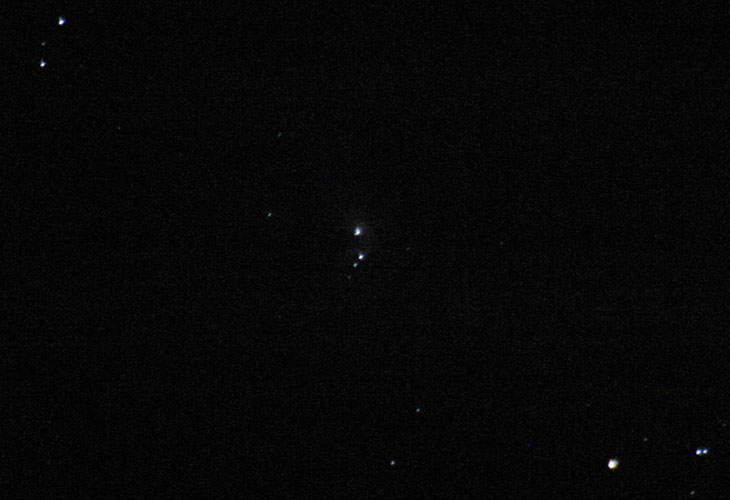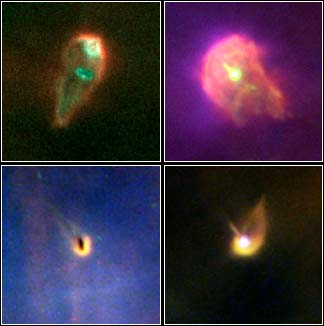 As wintertime drifts away here in the northern hemisphere, we’ll lose the opportunity to see the most recognizable constellation
As wintertime drifts away here in the northern hemisphere, we’ll lose the opportunity to see the most recognizable constellation on earth in the universe by human standards still visible in the evening sky: Orion. Shown here, but technically not in its entirety (there are more stars making up the bow and such, out of the frame,) this large and distinct constellation is usually the first learned by stargazers, and one of the most photographed by amateurs and professionals alike. The bright yellow star at extreme left is Betelgeuse, which is in the final stages before going supernova, whereupon it will likely become so bright it will be visible during the day, provided it happens sometime in northern hemisphere summer, or seriously light up the night sky for a few weeks if it happens in the opposite season. This will happen “soon,” meaning anytime within the next million years or so, making astronomical predictions somehow even less accurate than weather reports.
Clustered throughout most of the lower half are some of the more elaborate nebulae, including the Orion Nebula and the Horsehead Nebula, homes to brand new stars forming as you read this. Don’t bother running outside to watch it happen, since the nebulae aren’t visible to the naked eye, and star formation is a terribly slow process. The three belt stars, the very distinct line of stars almost vertical in this image, are truly just three stars – but the sword (ahem) stars visible nearby, dimmer and at a 45° angle, are entirely different. Looking like only three stars, binoculars or a low-power telescope will reveal there are actually many distinct stars in there; three in the middle, two at one end, three at the other. More resolving power will bring out many more – this is a neat thing about initial introductions to astronomy, since those blank spaces become stuffed with stars as you gain resolving power. And with a good scope, you can see the hidden secrets of Orion. Those sword stars are surrounded by the vast cloud of M42, the Orion Nebula. And in that cloud of gas and dust, we can see evidence that our speculations about the formation of planetary systems, like our own solar system, is accurate.

Or maybe not. The presence of other nearby stars could prevent that, or destroy it soon after beginning. The same conditions that make this nebula such a great region to see stars form also makes it less likely to produce the kind of planets we’d like to see: those capable of supporting life. Things are too crowded, and stars have some bad habits, like putting out huge amounts of powerful radiation and ending their lives rather spectacularly. Earth, brimming with life, exists in a special place in relation to our own star (we call it the “sun”) in that it is close enough to receive a certain amount of heat without getting overheated, and far enough not to have the oxygen/nitrogen atmosphere blown away by stellar winds. The atmosphere itself blocks a lot of the radiation that the sun hurls outward, so our delicate little bodies don’t get bombarded with Incredible-Hulk-producing gamma rays. Earth’s orbit is actually a “just right” distance for the size and nature of our sun, a place called the “habitable zone.”
Some maintain that the chances of this happening are so small as to be, literally, nonexistent, and that it was no accident that the Earth sits here. Statistically, this is utter nonsense – there are no probabilities that pass a certain point and become impossible. But the Earth can actually inhabit a broad band of orbital distances from our sun, broad enough that Mars almost sits within it – indeed, Mars shows signs that it once had an atmosphere. And bear in mind that the Earth’s orbit is elliptical, and it varies in distance form the sun by five million kilometers (three million miles) throughout the year. We can see how thoroughly this affects us here in the northern hemisphere by the fact that it’s the hottest when we’re the farthest from the sun (it’s the axial tilt of the Earth, and how both oblique angles and length of daily exposure affect the warming of the atmosphere, that makes our seasons.) There is nothing “too special” about Earth.
However, that little baby planet system up there might not be so lucky. Stars that are very big, or stars that are reaching the end of their lives, throw down some serious bad shit, a can of cosmic whupass that could take a protective atmosphere of gases and disperse it back into the nebula – our own sun will do that a few billion years from now (just not into the nebula, since we ourselves are not within one.) So having lots of stellar neighbors may not be so, um, stellar. It could mean that, just as life starts settling in and thinking of redecorating the ecosystem with more oxygen and carbon-exchanges, some big bad wolf huffs and puffs and blows the whole floating rock bare. Forever. Or at least until the home sun goes blooey itself and scours its orbiting system clean.

There’s a faint hint of it here in my shot showing just Orion’s Sword, corner to corner, but the brightest of those three stars making up the middle “star” of the sword is actually a cluster of stars itself, referred to as the Trapezium. The brightest of that cluster, called Theta1 Orionis C (or θ1 Ori C,) is our big bad wolf.

The timing of this is interesting, as well. The stars shown here had to have formed before θ1 Ori C reached its own strength, otherwise the stellar wind from it would almost certainly have prevented the coalescence of gases that eventually resulted in star formation. So this brash young upstart grew up in an established neighborhood and started wreaking havoc, driving the property values down for light years around. Now you know why homeowners’ associations exist. But don’t be too harsh on the lad, since the debris being blown away from those stars is exactly what can form life in other systems, as well – fused atoms of “heavier” elements that react much more readily to energy exchange at “low” temperatures, such as the kind we experience here on Earth. The spring wind destroys the puffball of the mature dandelion, but only succeeds in sowing those seeds elsewhere.
So, think about this the next time you’re gazing aloft on a cold clear night. That little speck of light in the middle features a maelstrom too tiny for our eyes to make out, but unbelievably vast in size nonetheless, and possibly seeding the surrounding emptiness with the building blocks of life. Most of the very atoms within our bodies went through conditions very similar, and will again, too. In fact, we haven’t the faintest way of determining if any part of us once resided within another lifeform from far away, billions of years ago. The possibility certainly exists.




















































